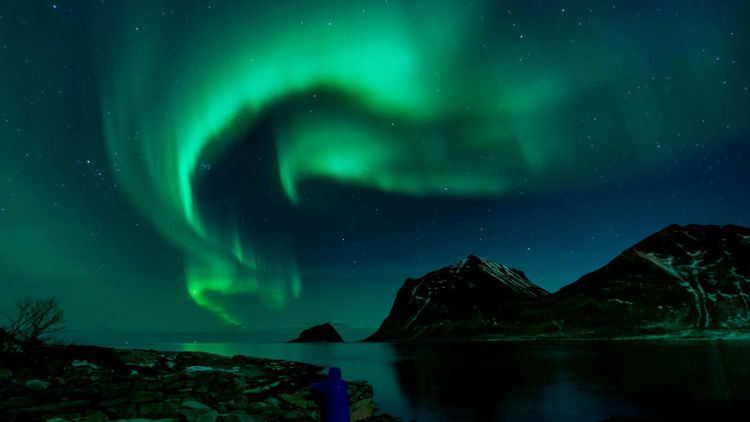Northern Lights Could Be Strongest Since May: Where To See ...

There may be a chance for Americans in the Northeast and Midwest to see the Northern Lights this week after a solar event known as a “Cannibal CME” caused scientists to predict Monday, Tuesday and Wednesday night’s auroras to be some of the strongest since May’s radiant light show.
The Northern Lights in Norway.
AFP via Getty Images Key FactsMonday night’s aurora has a Kp index of seven, the third highest aurora classification, which means it will move even further towards the equator and become “very bright and very active,” according to the National Oceanic and Atmospheric Administration.
NOAA also issued G1 through G3 geomagnetic storm watches throughout Wednesday night due to coronal mass ejections—eruptions of solar material—that merged together over the weekend and formed what’s known as a “Cannibal CME,” according to Spaceweather.com.
Cannibal CMEs are created when an initial CME is followed and engulfed by a second, much faster CME, creating a massive cloud of plasma that can cause strong displays of the Northern Lights.
This week’s Cannibal CME was caused by a series of M-class solar flares—medium-sized flares—and is accompanied by a train of other CMEs that are expected to reach Earth no later than Wednesday.
May’s dazzling light show was also caused by a Cannibal CME, and although this week’s lights won’t be as bright, they’re expected to be some of the strongest lights since May’s aurora.
Though it’s difficult to predict when exactly the lights will arrive, NOAA expects most of the activity to happen on Tuesday night, but people in many places in the continental U.S. may see the Northern Lights on Monday and Wednesday as well.
While it’s hard to pinpoint where exactly the lights will be visible, NOAA offers a forecast with a potential viewline (see below). U.S. states within the aurora’s view line include Alaska, Washington, Oregon, Idaho, Montana, Wyoming, North Dakota, South Dakota, Nebraska, Minnesota, Iowa, Wisconsin, Illinois, Michigan, Indiana, Ohio, Pennsylvania, New York, Vermont, New Hampshire, Massachusetts, Connecticut, Rhode Island and Maine.
The Northern Lights view line.
NOAA What’s The Best Way To Photograph The Northern Lights?The lights are usually most active between 10 p.m. and 2 a.m. EDT. For the best views of the Northern Lights, the agency advises traveling as close to the poles as possible, avoiding city lights and other light pollution, monitoring weather forecasts for prime viewing conditions and finding a position on a vantage point like a hilltop.
Key BackgroundThe Northern Lights that have been appearing in the U.S. and other parts of the world since in May are the result of very active sunspots NOAA has dubbed NOAA Active Region 13664. These sunspots led to an incredibly strong G5 geomagnetic storm in May, which is the highest label storms can be given. Researchers aren’t sure why May’s storm was so severe, but they think it may be due to the quick succession of multiple coronal mass ejections leading to what they call Cannibal CMEs. As a result, May’s lights were the strongest since the Halloween solar storms of 2003. An event called Solar Cycle 25—the cycle the sun goes through around every 11 years—has been the cause of geomagnetic storms that have resulted in recent sightings of the Northern Lights, and NASA predicts it will continue on into 2026. Cycle 25 began in Dec. 2019, and it’s estimated it will reach its maximum—when activity is expected to peak—between late 2024 and early 2026. It’s projected to peak with 115 sunspots, which are where geomagnetic storms originate. Although the maximum hasn’t happened yet, the sun’s activity has been busier than scientists anticipated, so it’s possible there will be even more geomagnetic storms leading up to 2025, though it’s difficult to predict exactly when these storms will occur.
Follow me on Twitter or LinkedIn. Send me a secure tip.









































